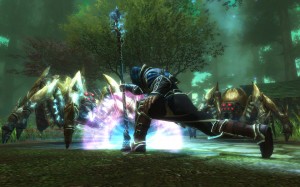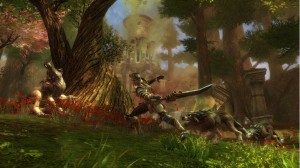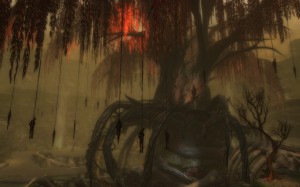What IS Kingdoms of Amalur: Reckoning?
- Updated: 18th Jan, 2012
 The demo for Kingdoms of Amalur: Reckoning was released on Xbox Live and PSN this week. Some have criticised it for clinging to old fantasy RPG tropes. Others have called it “the game that Lionhead have been trying to make for three iterations.” I’ve spent hours playing on preview builds of the game, so here’s the score.
The demo for Kingdoms of Amalur: Reckoning was released on Xbox Live and PSN this week. Some have criticised it for clinging to old fantasy RPG tropes. Others have called it “the game that Lionhead have been trying to make for three iterations.” I’ve spent hours playing on preview builds of the game, so here’s the score.
The Concept
Amalur is a massive and original fantasy world with a rich, detailed history from R. A. Salvatore, author of the Forgotten Realms series. Reckoning is set in this universe during the Age of Arcana when magic filled the air, a long and bloody war waged across the landscape and blah, blah, blah. There’s a phenomenal amount of information online, as well as a fancy map of the kingdoms so those who want to know more can head over to the Amalur website.
The Game
You’re the one person with the ability to defy fate, turn the tides and change the world. So far, so generic. However, what Reckoning chooses to do, it does very well. You’ve a wide range of combat options, armour, weapons and spell types. The characters you meet are written with personality. The world itself is filled with factions to join, dungeons to explore, jails to break and gewgaws to discover.
Once you get through the opening area of the game, you’re free to explore the realm of Reckoning however you wish. Areas are designed more around zones, so it’s not quite as free-roaming as Skyrim or Fallout, but you can happily pootle about smashing crates, picking flowersreagents and ignoring the main questline for days if you want. In the my half-dozen hours of hands-on experience I’ve only explored a couple of towns but already I’ve discovered quests and attitudes that flesh out a world of internal politics and explorations of racism as well as more quirky quests, like the were-man-wolf.
Combat
Fighting your opponents in Reckoning flows nicely for button bashers like me. It’s no mind-blowing Arkham City but there are plenty of options to keep you busy. You’ve a button for your primary weapon and one for your secondary, which is usually ranged. Slot in your weapons, bash the appropriate buttons and job done. As with every melee game that isn’t Batman, you will occasionally find yourself swinging wildly at thin air with all your enemies behind you but that’s okay. A capable dodge and some nice ranged spells make it easy enough to get back into the action.
For your primary weapon, you have eight different types:
- Greatswords
- Longswords
- Hammers
- Daggers
- Faeblades (Fae are the Amalur version of elves)
- Staves
- Sceptres
- Chakrams (I haven’t seen one yet but if they’re not straight out of Xena: Warrior Princess, I shall be disappointed)
Each of these feels very different and despite only having one proper button, you can work up a satisfying variety of attacks. With a longsword, bash the button in quick succession and you’ll chain together up to 4 moves. Hit once, pause and hit again at the end of your swing, you’ll send your opponent flying into the air and can then hit him with the 4-move combo. More combos are unlocked by the skill tree.
 Staves, on the other hand, are a ranged weapon. Hit once to shoot flames. Chain 3 together for a more devastating and far-reaching cone of attack or hold down the primary attack for a charged area-of-effect blast to send your enemies flying.
Staves, on the other hand, are a ranged weapon. Hit once to shoot flames. Chain 3 together for a more devastating and far-reaching cone of attack or hold down the primary attack for a charged area-of-effect blast to send your enemies flying.
The ability to switch between primary and secondary weapon on the fly is very useful. I like to get up close and personal but after running into a pack of four wolves and a bear yesterday, I very much appreciate not having to dig into a menu, find weapon, swap weapon, wait for animation, fight with new weapon. I could just block or dodge away from the pack and flip straight into my secondary longbow or hold down the right trigger and press the buttons to throw spells at my attackers. It’s incredibly responsive and very simple to learn.
As you are the Special One, you also have the power to enter something called Reckoning mode once you’ve killed enough enemies to charge your meter. This power allows you to slow down time, cripple a group of foes and stab one of them through the heart with a giant stick of light and suitably flashy cut-scene that leeches Tendrils of The Future (or whatever) from all crippled nearby enemies. Lovely.
The Skills
One of the core design philosophies for Reckoning was that they never wanted to shut doors on the player. As systems designer Will Miller told me in our Reckoning interview, there are no mutually exclusive quests. The same applies to skills. Every time you level up, you get to put points into your choice of three separate skill trees.
- Might: This focuses on your combat abilities, improving and unlocking attacks with greatswords, longwords and hammers.
- Finesse: These give you bonuses to dodging and stealthy assassination skills while unlocking attacks with the daggers and faeblades
- Sorcery: Magic, unsurprisingly. Staves and Sceptres, mana and the usual things you find here
Your choices in the skill trees will unlock destiny cards – essentially class-like bonuses, only you can switch them in and out at any time. Going brawling in the forest? Put in your fighter destiny. Oops, hit the wrong guy and got put in jail? Switch to your rogue destiny and sneak around. It’s an excellent way to give players the freedom to experiment and multi-class without harsh penalty.
Inventory and Crafting
 Inventory management is very basic but in a good way. At the start, you can carry up to 70 items. That’s it. Everything I picked up counted towards 1 inventory slot. Chest pieces, daggers, daggers, whatever. Potions and reagants are stackable and it’s all arranged in controller-friendly collapsible lists.
Inventory management is very basic but in a good way. At the start, you can carry up to 70 items. That’s it. Everything I picked up counted towards 1 inventory slot. Chest pieces, daggers, daggers, whatever. Potions and reagants are stackable and it’s all arranged in controller-friendly collapsible lists.
Reagants for potions can be found all over the landscape. Certain skills will also allow to harvest rarer items from bodies. Unlock recipes to make potions or simply experiment to figure things out on your own. Many of you will be familiar with Skyrim’s version of this – everyone loves tearing wings off butterfly wings and eating them, right? As with the combat, Reckoning’s version appears much simpler but with underlying complexity. You can also collect shards to modify weapons. Properties for these are unlocked the same way – through experimentation (or wiki research).
The demo for Kingdoms of Amalur: Reckoning is out now on PSN and Xbox 360.
If you have the means, I really recommend you to give it go. As the for the game itself, it comes with various pre-order bonuses depending on who you order with (as usual)
- Game: You get the Fate-Touched Weapons pack. One of each type of weapon, which allows you to stay in Reckoning mode for longer.
- The Hut: You get the Ultimate Treasure Hunter’s Pack containing a Dowsing Rod, which makes all reagents visible on the map.
- Play.com: The Destinies Choice pack will give you an extra destiny card from the start, the Compass of Fate which grants you a bonus to persuasion and three unique armour sets, boosting Might, Sorcery or Finesse.

Follow Us!